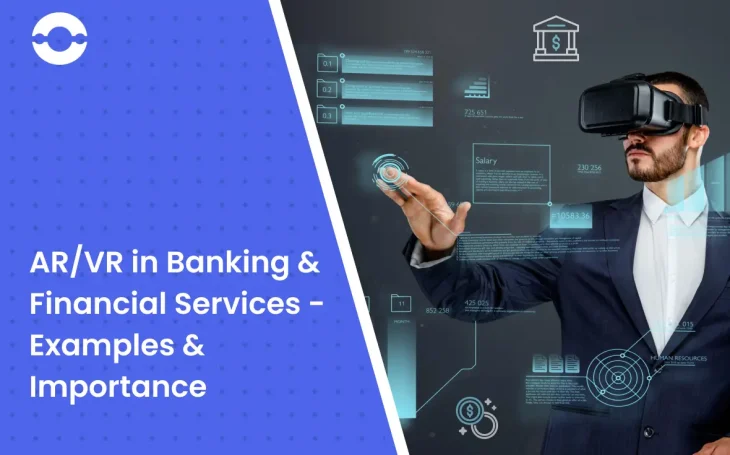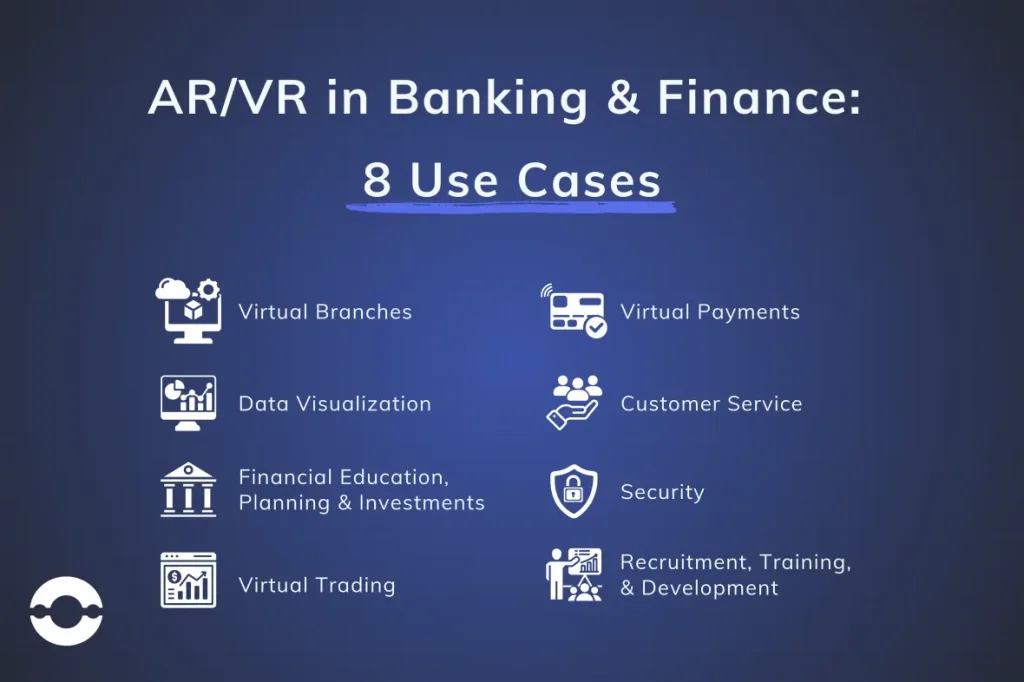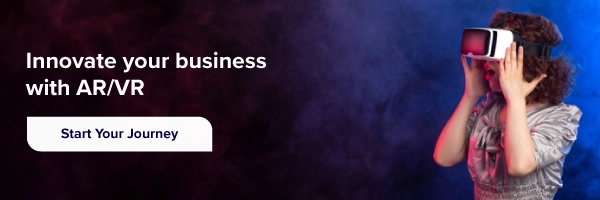
Many banking and financial institutions nowadays are embracing modern technologies, AR/VR is one such solution.
AR/VR in banking and finance is helping companies offer an enhanced experience to customers whilst also assisting them with better financial and investment decisions. Since this industry has high monetary stakes, these key benefits of VR/AR in banking and finance are enough to persuade institutions/businesses to adopt them.
However, to make the case more compelling, we will highlight the importance, use cases, and examples of AR/VR in the financial and banking sector in this blog.
So just grab your pen and dairy and note the points that tell you how Augmented Reality and Virtual Reality could change your financial and investment decisions for good.
Importance of AR/VR in Banking and Financial Services
Like many other major industries, AR/VR is also transforming the banking and financial sectors. The importance of AR/VR in banking and finance has been highlighted through enhanced customer experience and streamlined workflows.
Customers have been given the option of face-to-face interaction with their desired financial service provider, through a virtual or augmented reality environment. This has been viewed as the top benefit gained out of AR/VR in financial services and banking.
An enhanced view of banking is offered through a virtual experience that bridges the gap between a banking branch and the potential or existing customer. Advanced interactivity models allow users to engage in smooth virtual conversations, giving an experience similar to the contact center experience.
With virtual reality, banks and financial institutions could also add the voice recognition feature for authenticating consumer conversations and transactions; adding to the security provisions. However, this would also require strong security identification measures, for the feature/technology to be widely accepted and adopted.
Therefore, Augmented Reality and Virtual in Banking and Binance offer the Following Benefits:
- Better customer service and engagement
- Facilitates financial literacy
- Offers customized experiences to customers
- Supports remote collaboration
- Helps with risk management and security
- Seamless mobile payments through QR codes or other markers
- Ensures asset security
Now that we have seen some of the benefits of augmented and virtual reality in banking, let’s look at the multiple use cases and AR/VR in banking examples in the next section.
AR/VR in Banking and Financial Services- Use Cases
Did you know that virtual reality can be used to provide customers with virtual product demonstrations?
In fact, banks use VR to demonstrate the features and pros of the investment products offered by them, allowing customers to better understand the product and make an informed investment decision.
Interesting, right? But that is just not it. AR and VR in banking and finance can and do much more.
There are multiple use cases and examples of AR/VR in the banking and financial industry. Some of the key ones are:

1. Virtual branches
One of the main use cases of AR/VR in banking and finance is the creation of virtual banks or branches. These branches will enable customers to access banking services from anywhere, from the comforts of their homes or on the go. This will be possible through VR headsets or other VR-powered devices.
This will not only bring the bank to the customer and enhance their experience but also help banks save funds invested in the building and maintenance of the physical branches.
While this has not been explored and adopted in the industry yet. However, the pace at which AR/VR technology is maturing and penetrating the banking industry could be the new way of bank visits soon.
2. Data visualization
The banking and financial domain is a complex data to comprehend, process, and decide. Minor misinterpretations or errors in viewing could cost millions. Thus, this data abundance industry could have used technology to simplify data absorption.
AR/VR in banking and financial services helps with data simplification and organization. It allows traders to visualize and track important data in an immersive and interactive environment. This facilitates sound decision-making about wealth management.
Salesforce, for example, leverages Oculus Rift, a virtual reality headset, for the creation of an immersive 3D environment for data analytics.
Similarly, Westpac Banking Corporation offers financial data visualization and budgeting using smartphone-based AR.
This application of AR/VR in banking and finance services has also allowed financial companies to better assess their reporting insights. Financial information/data depicted through charts, graphs, and the resultant predictions can all be viewed in a 3D, interactive environment.
This facilitates better engagement with the models and hence, better financial outcomes. Every data point could be analyzed with greater detail and focus.
For example, Fidelity Labs, a part of Fidelity Investments, created a virtual world called “StockCity”. Accessible through Oculus Rift, stock portfolios are turned into a virtual 3D city here, and investors immerse themselves in the financial data world through headsets.
Also read: How Much Does It Cost to Develop an AR App?
3. Virtual Trading
Virtual trading is another key application of AR/VR in banking and finance. Financial companies are coming up with VR workstations for trading. This allows users to work on desktops, smartphones, and virtual rooms and interact with virtual agents for financial advice.
Multiple stakeholders can collaborate and enhance the outcomes by collective analysis of critical data.
Citi, for example, leverages AR integrated into Microsoft HoloLens to give traders Holographic Workstations. 2D and 3D elements are added to the bank’s existing processes with the workstation. As a result, financial clients could view complex data in a simplified manner.

While TD Ameritrade, a stockbroker, offers an electronic trading platform and thus, a virtual experience. Starting with a street view, the app teaches users how to work the stock exchange space. Later, it introduces a helicopter view of live markets through holography and 3D charts to offer real-time guidance.
Lastly, Comarch utilizes VR in its wealth management software to offer better algorithms and trading tools access to users.
4. Financial education, planning, and investments
AR/VR in banking and finance helps industry professionals and patrons get in-depth knowledge of the field and better equip themselves for its work. AR/VR tools help in educating customers and employees on a bank’s or a financial company’s investment and business projections through data visualization.
Desjardins Bank’s integrated AR platform– Your Way Desjardins, for example, offers a virtual assistant Penny. This assistant, with the help of interactive videos and data storytelling, helps to educate customers.
AR tools can also be used to help customers with financial planning as well as investment decisions. Augmented reality offers customers real-time information about investment products like stocks, bonds, and mutual funds. This information is displayed in an interactive and absorbable manner to the customer for better understanding and informed decisions.
Difficult financial ideas are made approachable and comprehensive through AR. Digital content is superimposed on physical items to make the data more interactive and easier to understand. Customers can interact with virtual representations like 3D graphs or simulations for investment ways, budgeting methods, or financial planning.
Even Penny makes recommendations about saving plans to customers by carefully understanding their requirements and portfolios. The platform also offers retirement plans and investment advice.
5. Virtual payments
Using augmented and virtual reality in banking and financial sectors, even payment has been made a virtual experience. Especially during the pandemic when there were outdoor movement restrictions, virtual and digital payments came in handy as more and more e-commerce businesses took over the market.
MasterCard, for example, has partnered with Wearality, to create a virtual space where even payments can be made along with the purchases. A VR golf experience called ‘Priceless’ allows players to choose and buy clothing in a virtual environment.
Furthermore, at the 2018 Mobile World Congress, a mobile technology show hosted every year in Barcelona, Visa (a leader in digital payments) launched an AR app capable of displaying a food location heatmap over the user’s environment. This allowed users to interface with the apps to point to specific portions and buy meals.
6. Customer service
The importance of AR/VR in banking and finance could be reviewed through improved customer service or experience. Many banking institutions offer AR apps to their customers. These apps help them find the closest bank branches and ATMs.
Customers could just scan their outdoor environment with their smart devices and view real-time information about the nearby branch location, distance, services, etc. Augmented reality overlays a user’s real environment with crucial and desired information.
In addition, multiple financial institutions offer virtual experiences to their customers. These experiences allow customers to seek help/advice in a completely virtual environment, without even taking a step outside of their homes.
The virtual assistant takes all the queries and makes the information absorbable and engaging through informative visuals and interactive data. This also helps with educating a customer about financial services, investment and saving plans, etc.
Research states that compared to other mediums, VR can facilitate better communication.
Halifax, a British banking brand, and Commonwealth Bank in Australia, both leverage AR to make processing requests more frictionless.
Similarly, Ukrainian Privat Bank is using AR to show how customers’ information can be combined with the technology; enabling them to perform all their banking virtually.
The Bank of Osman has empowered its app with deal-finding algorithms. As a result, users can find an ATM within a mall and also find special deals in selected stores.
7. Security
Cybercrime and data breaches have been making headlines for a long time now. This is one consequence of increased technology adoption. However, it is being tackled by different industries and sectors in multiple traditional, new, and effective ways.
Some banking and financial institutions have started using AR and VR login procedures as a way to improve security. This involves biometric scans of the user’s face or irises to verify their identities. Virtual environments could also use voice recognition for enhanced security.
VR further helps with risk management and security in the fintech business. VR simulations help with checking the effectiveness of cybersecurity systems and detecting potential risks. Additionally, the simulations could also help users analyze the impact of different economic scenarios or market situations on investment portfolios or lending practices.
These virtual reality simulations enable customers to make informed and sound decisions and prepare for any contingencies.
In fact, Axis Bank was the first Indian bank to leverage AR in conjunction with an iris scan for Aadhaar-based verification for micro-ATM apps back in 2018. The built-in AR view feature also made available real-time information about the nearby branches and ATMs.
Must read: Use Cases of Blockchain Technology- Banking and Business
8. Recruitment, training, and development
With the increased adoption of technology in different sectors, institutions/businesses need to ensure that their employees /staff are well-versed with the solutions and systems.
To ensure this, some banks are providing VR experience to their employees for training and development purposes. In fact, a study highlighted that VR platforms offer higher subsequent knowledge retention.
Existing as well as potential employees come together in teams and come up with ideas for apps that will further enhance customer experience.
Conclusion
AR/VR in banking and finance could really change the way financial institutions and customers interact and do business. These technologies offer myriad opportunities for increased and fruitful customer interactions, customized experiences, financial education, better communication, and risk management and security.
Moreover, some of the present and future generations are tech-savvy. They want simplified and digital experiences. In fact, 73% of millennials turn towards Google, PayPal, and Apple for financial products, in place of local banks. Furthermore, 33% feel that banks might not even be necessary soon.
So, you as banks need to give the future generations the kind of service, they except and seek!
And, to cater to future customers’ needs, keep up with the evolving times, and stay relevant, you have to accept, adopt, and master modern technologies, including AR/VR, AI/ML, Blockchain, etc. This will also help you make the banking and finance industry an appealing choice for potential, future-generation job seekers.
And we are here to assist you exactly with that!
BigOh with its modern and cutting-edge technological solutions has helped multiple clients from the banking and financial sectors to revolutionize their services, and operations and attract and retain more customers.
With our AR/VR app development services, we don’t just build your apps, we ideate, design, test, and maintain your app for the optimization of resources and growth of business!
So, get in touch with us today and cater to the changing times and customer needs seamlessly!




